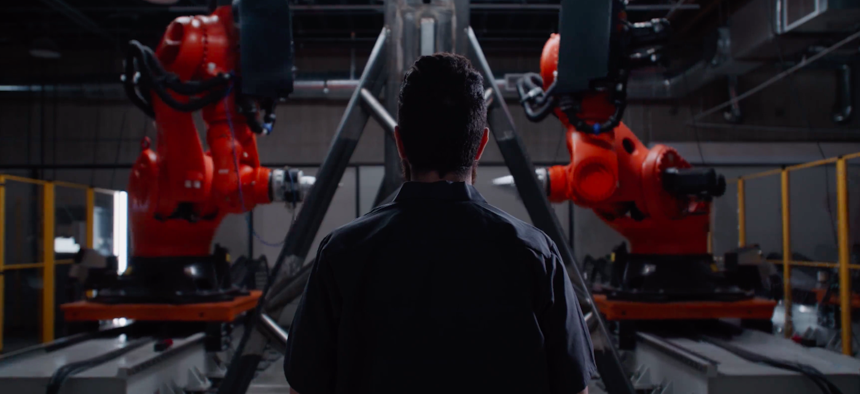
A still from the Machina Labs website depicting AI-assisted robotic parts forming Machina Labs
The Air Force is quietly revolutionizing parts replacement
A startup's robotic system that fits on a truck could replace sprawling die-based factories.
The U.S. military spends billions on replacement parts for aircraft each year, with the Air Force requesting $1.5 billion for parts in the next fiscal year alone. Now, officials at Robins Air Force Base in Georgia, working with a startup called Machina Labs, say they’ve found a robotic AI-driven solution to those high costs. And the new technique could also significantly shorten the supply chain, allowing replacement to happen closer to the front lines.
Machina Labs’s solution is called the Robotic Craftsman. The technique applies artificial intelligence to the job of crafting shapes into metal with human precision, and then uses robotic arms to fold the metal into place.
“It's not that we're just deploying robots to old technology. It's a completely new technology developed from scratch.” Edward Mehr, one of the co-founders of Machina Labs, told Defense One.
The Warner Robins Air Logistics Center has had one of the systems at its depot since November. Shane Groves, a subject matter expert at the center, told Defense One that the system has helped them take six months off the time it takes to get a part.
And, he said, it’s a lot easier to maintain than the traditional system, which has a lot of difficult-to-replace components.
“Not only are they aging, but the pumps and the valves and bladders that are used are very maintenance prone and require a significant amount of upkeep. The amount of infrastructure needed and the amount of space needed to replicate the same functionality [with the Robotic Craftsman] is much less,” he said. The parts themselves are “three times more affordable.”
Beyond parts repair, Mehr hopes rapid manufacturing could play a big role in one of the Pentagon’s newest projects, the mass production of tens of thousands of low-cost drones, dubbed Replicator. He said he’s talking to integrators as well as the people in the Defense Department about it.
“The angle we're taking is around the speed of delivery and manufacturing…Let's say if you're making 14 different versions of drones, then you have to make 14 different manufacturing lines. And if you use traditional manufacturing techniques, that means we need to have 15, 16 different versions of the production line,” as opposed to one production line that adapts to different needs, he said.
In terms of the military’s future needs, the system’s most important asset may be its small size, with the current version able to fit on the back of a truck. A smaller infrastructure footprint could mean not only cost savings, but also allow troops to move repair work—or drone making—much closer to the battlefield. That’s something the Ukrainians have done with great success, and it allows for much more nimble operations as well as decreasing the vulnerability of supply lines. It could be particularly useful in the Pacific, where parts resupply is fraught with logistical and political challenges.
“The first phase for us is just deployment into the depots. We're working on potential deployment into the battlefield. We're working on the next version that's a little bit more hardened,” Mehr said. The hope is to have a battle-hardened version at some point this year.
NEXT STORY: Sentinel flight test delayed more than 2 years
